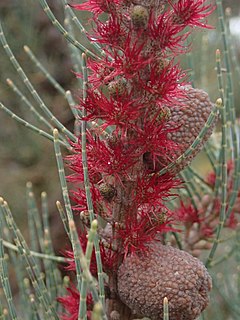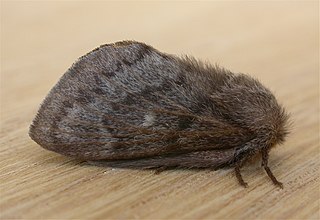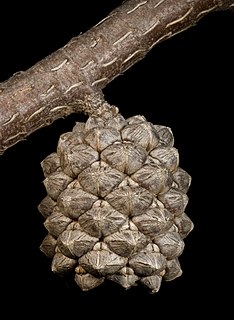Ironwood is a common name for many woods or plants that have a reputation for hardness, or specifically a wood density that is heavier than water, although usage of the name ironwood in English may or may not indicate a tree that yields such heavy wood.

Allocasuarina is a genus of trees in the flowering plant family Casuarinaceae. They are endemic to Australia, occurring primarily in the south. Like the closely related genus Casuarina, they are commonly called sheoaks or she-oaks.

Casuarina is a genus of 17 tree species in the family Casuarinaceae, native to Australia, the Indian subcontinent, southeast Asia, islands of the western Pacific Ocean, and eastern Africa. It was once treated as the sole genus in the family, but has been split into four genera.

Allocasuarina torulosa, the rose she-oak or forest oak, is a tree which grows in sub-rainforest of Queensland and New South Wales, Australia. Originally described as Casuarina torulosa by William Aiton, it was moved to its current genus in 1982 by Australian botanist Lawrie Johnson. It is the type species of the genus Allocasuarina.

Allocasuarina humilis, commonly known as the dwarf sheoak or dwarf casuarina, is a woody shrub of the family Casuarinaceae endemic to the south-west of Western Australia.

Allocasuarina distyla, commonly known as scrub she-oak, is a shrub or small tree of the She-oak family Casuarinaceae endemic to New South Wales.

Angophora hispida grows as a mallee, or as a tree to about 7 m (25 ft) in height. A. hispida's small size, especially when compared to its Angophora and Eucalyptus relatives, leads to it being known by the common name dwarf apple. It is native to a relatively small patch of central New South Wales – from just south of Sydney up to the Gosford area. The plant's leaves are sessile (stalk-less) and hug the stem with heart-shaped bases. Its previous name – A. cordifolia – referred to these cordate leaves. Another distinctive feature are the red bristly hairs that cover the branchlets, flower bases and new growth. This leads to the specific epithet hispida.

Allocasuarina luehmannii is a species of ironwood tree native to Australia and its wood is the hardest commercially available.

Pernattia pusilla, the she-oak moth, is a species of moth of the family Lasiocampidae. It was described by Edward Donovan in 1805 and is found along the coast of eastern Australia.

Allocasuarina crassa, commonly known as the Cape Pillar sheoak, is a species of sheoak native to Tasmania, Australia.

Allocasuarina inophloia, also known as woolly oak, or stringybark she-oak, is a shrub or small tree of the she-oak family Casuarinaceae endemic to inland New South Wales and Queensland. The hairy bark is an unusual feature.

Abantiades leucochiton is a moth of the family Hepialidae. It is endemic to Australia, where it is found in New South Wales, South Australia and Victoria.

Allocasuarina acuaria is a shrub of the genus Allocasuarina native to the Wheatbelt, Goldfields-Esperance and Great Southern regions of Western Australia.

Allocasuarina acutivalvis is a shrub or tree of the genus Allocasuarina native to the Wheatbelt, Goldfields-Esperance and Mid West regions of Western Australia.

Allocasuarina dielsiana, commonly known as the Northern sheoak, is a tree of the genus Allocasuarina native to the Mid West and Goldfields-Esperance regions of Western Australia.
Allocasuarina fibrosa, commonly known as the woolly sheoak, is a shrub of the genus Allocasuarina native to a small area in the central Wheatbelt region of Western Australia.

Allocasuarina spinosissima is a basionym of Casuarina spinosissima. It is a shrub of the genus Allocasuarina native to a small area in the Wheatbelt and Goldfields-Esperance regions of Western Australia.

Desert Camp Conservation Reserve is a protected area in the Australian state of South Australia located in the state's Limestone Coast in the gazetted locality of Marcollat about 44 kilometres (27 mi) south of the town centre in Keith. It is classified as an IUCN Category VI protected area.

Allocasuarina striata, commonly known as the small bull oak, stalked oak-bush or the tall oak-bush, is a shrub of the genus Allocasuarina native to South Australia.

Allocasuarina pusilla, commonly known as the heath oak-bush or the dwarf she-oak, is a species of Allocasuarina genera native to Australia.



















